|
FAQs on Characoids/Tetras & Relatives Disease Treatment
FAQs on Characoid Disease:
Characoid Disease 1,
Characoid Disease 2,
Characoid Disease 3,
FAQs on Characoid Disease by Category:
Diagnosis,
Environmental,
Nutritional,
Infectious,
Parasitic,
Social,
Related Articles:
Characoids/Tetras &
Relatives,
Related FAQs:
Characoids/Tetras & Relatives,
Characoid Identification,
Characoid Behavior,
Characoid Compatibility,
Characoid Selection,
Characoid Systems,
Characoid Feeding,
Characoid Reproduction,
|
Beware of metal and formalin containing medications.
Toxic
|
|
Cardinal tetra with balloon like scales
10/8/19
Dear WWM,
My cardinal developed a single, large, solid white, ball-like spot on its
flank about 2 weeks ago. It seemed completely active and normal otherwise
and the single spot was unlike anything I could find pictures or
descriptions of. After speaking to the fish store who didn't think it looked
fungal, I decided to watch and wait. The "spot" disappeared after 7 or 8
days. At this point the fish developed some fluffy cotton wool like patches
which seemed more classically fungal, and another in the shoal of 8
cardinals also seemed to show a small patch of something similar. I put the
two fish in a hospital tank and started to treat with a treatment called
Dessamoor, which contains copper sulphate, ethacridine lactate, Methylene
blue, and Acriflavine chloride. I followed the dosing instructions
accurately but when I checked in on the fish after about 4 or 5 hours (who
had seemed pretty normal behaviourally despite the cotton wool), they had
lost most of their colour. I guessed that if I left them there they would
die. So I put them back in my community aquarium and just watched. Over the
next week, the fish with the more obvious problems seemed to get more of the
growth. The other one's possible cotton wool tuft seemed to clear up. Then I
realised about two days ago that the scales of cardinal with the greater
problems seemed to have swollen up hideously - see picture attached. I'm not
sure when this started - it's possible that the 'cotton wool' appearance was
an early stage of the process. It was a bit difficult to see well in a well
planted 120 L tank.
I have now put this poor fish in a separate container (my "hospital" tank is
currently occupied by an aggressive dwarf gourami). I will buy a new
hospital tank for the cardinal tomorrow. I wanted to try salt but I've read
that cardinals tolerate it poorly. I have just bought Melafix and Pimafix
and was going to try these empirically - but having read other advice on
your website it seems these don't do anything. So I am at a loss. I have no
idea what to do or what the disease is. Oddly, the fish is active and until
I separated it was behaving as normal and eating well. Now it's stressed,
buzzing intermittently about its container, and won't eat, but I am pretty
sure the latter is stress-related rather than due to the illness. The 7
other cardinals all look fine, as do 3 corys and an Ancistrus. I've a couple
of dwarf gouramis as well. They occasionally seem to get agitated and brush
against plants as if they are itching these past 3 or 4 days. But they have
no external stigmata thus far, and most of the time look and behave normally
and seem happy enough.
Finally, the problems seemed to start when over a 2-month period I cleaned
the tank about 2 times only given holidays etc. Usually I do a partial water
change (approx 30%) weekly. After separating the cardinal a couple of days
back, in the absence of knowing what if anything to treat the main tank with
I did a 70% water change and rinsed all the plants, driftwood, gravel. My
water parameters are nitrite 0, nitrate 25 mg/L, general hardness >16°,
carbonate hardness 20°, pH 6.8, Cl2 0.
Please help...!
Sanjeeva
<I am not optimistic here. The bubbles are epidermal tissue that has
swollen up with tissue fluid, and now protrudes past the scales.
It's the sort of thing we'd call Dropsy if the swelling was internal.
There's no obvious solution here. A good antibiotic might be worth a shot.
The use of salt, at 2 gram/litre, is perfectly safe with Amazonian fish such
as Cardinals for short periods (a few days or weeks) and is actually much
less stressful than traditional medicines such as formalin and organic dyes.
It's a tough one. If this fish is stressed, then humanely destroying it will
be the best move. But if it's feeding and otherwise behaving normally, you
might elect to medicate. Good luck, Neale.>
|
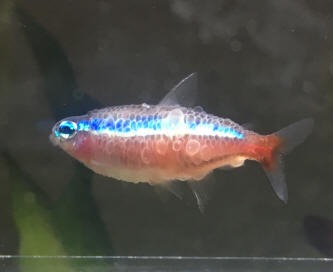 |
|
Columbian tetra with fin rot from nipping
5/20/18
Hi Neale and Bob,
<Susan,>
You helped me save a zebra Danio who was badly injured from a bullying
situation. He has healed beautifully and your suggestions on rearranging the
tank and reintroducing the Danios solved the bullying problem.
<Well, that's a good outcome!>
One of my Columbian tetras appears to be the victim of fin nipping with
accompanying fin rot now setting in. There are two spots visible (see photo).
This school usually gets along great although they do chase one another on
occasion.
<This species is prone to that. Bigger groups usually help fix the problem. In
any event, medicate as per Finrot.>
I do weekly water changes of 20%. Water parameters are as follows: Zero for
ammonia and nitrite. Nitrates around 20 ppm, gH at 7-8°, temp around 76°F, pH
6.8. I run a canister filter with biomedia that includes matrix and chemical
filtration is Chemipure green. I also run a sponge filter rated for 20 gallons
which is connected to a battery backup air pump (we have frequent power outages
where I live).
<Oh!>
Other tank inhabitants are a school of orange laser Corydoras and MTS (substrate
is sand) and Nerite snails. Tank is a 20 gallon planted. I have upped my water
changes to 10% every 3 days since I discovered the fin rot. It does not appear
to be getting worse and the tetra is active and eating but I don't want it to
progress further. I can't use aquarium salt because of the Corys.
<Who told you that? Low salt doses, i.e., 2 g per litre, for treating Whitespot
for example, will do them less harm/cause less stress than traditional
medications using copper or formalin. To be clear, catfish aren't "allergic" to
salt. That's a myth. A lot of salt in the water will cause osmoregulatory
stress, but trivial salt doses are perfectly safe, even with soft water
specialists like Cardinals, let alone Corydoras.>
I do have SeaChem Paraguard on hand that I used to treat my Betta who had fin
rot when I purchased him. Do you think its advisable to treat the tetra in the
tank with Paraguard?
<I would.>
I can relocate the Nerites and the larger MTS who are active at night and
visible on the substrate. MTS are expensive here and only available online so I
would prefer not to kill them off.
<Understood. While Melanoides snails usually handle medications just fine, you
could dump a few in a loosely covered food container with a bit of water and
leave them out of the tank while medicating. They need little care and will go
dormant when cool. The Nerites perhaps a bit more a gamble, being more sensitive
generally.>
I can also transfer the tetra to a small hospital tank.
<Perhaps put the snails here?>
I had ordered Kanaplex with the intention of adding it to food with their binder
Focus, but I was sent the wrong product so it will be about 5 days until the
Kanaplex arrives. The Kanaplex was my backup plan if the water changes didn't
help. What is the safest course of action in your expert opinion?
<Any medication for Finrot should be fine here. This fish looks in robust
health, and really all you want to do is help knock back the bacteria a bit so
it's own immune system can kick in.>
Thanks for your help (again).
Susan
P.S.
I'm moving everyone to a 50 gallon planted tank that has just finished cycling
once it was settled in and aged a bit. Hopefully that will solve the territorial
problems.
<Understood. Cheers, Neale.>
|
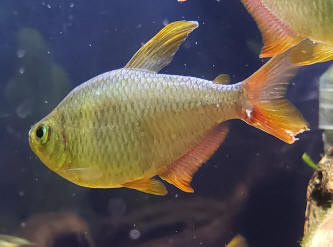 |
|
Re: Columbian tetra with fin rot from nipping
5/20/18
Thanks Neale!
I am happy to learn that corys can tolerate salt if I ever have to use it in my
tank.
<To be clear, as a short-term treatment for Whitespot and Velvet at low doses (2
g/l, for a few days or a couple of weeks). Perfectly safe used that way. But I
would not be adding salt as a regular addition to any community tank containing
relatively soft water fish, whether Corydoras, tetras or anything else from the
Amazon Region.>
Another myth busted.
<It would seem so!>
I went ahead and removed my snails and I'm treating with Paraguard. I will
definitely follow your advice and increase my school of tetras once I've
relocated them to the 50 gallon.
<Cool.>
Thanks again for your help.
Susan
<Most welcome. Neale.>
|
Minor Serpae Tetra fin rot? 11/2/14
Greetings. I have a 55-gallon aquarium that we set up 2 years ago & has
been stable and disease-free. Water parameters are: ammonia = 0, nitrite
= 0, nitrate = 30, phosphorous = 0. I do a water change every week. We
have live plants (water sprite wisteria). The inhabitants are 2
Bristlenose Plecos, 8 black-skirt tetras, 8 white-skirt tetras, 11 minor
Serpae tetras, and about 6 apple snails. The Serpae tetras were
introduced about 2 weeks ago and my quarantine tank currently is housing
some baby Gold Gouramis, so
I chose not to quarantine them. I know I should have, but I have never
had any problem with the tetras from this source. A bad decision on my
part, but anyway, may I explain the problem to you...?
<Fire away.>
Oddly enough, the other fish in the tank seem to be still healthy and
unaffected by this disease bothering the serape tetras. It is the
strangest thing I have ever seen. The first sign is a very pale area
where the dorsal
fin meets their body. It's very clearly delineated and easy to see
against their red-orange background. Soon after that, the dorsal fin
degenerates and the fish seems to die within a day or two after they
reach that stage.
They don't seem swollen and neither do they show any other signs of
illness. I have never seen fin rot behave like this or fin rot that just
affects one species of tetra. Today, I got some API Triple Sulfa and am
planning on giving them the entire course of treatment as directed by
the manufacturer. Do you think that I am on the right track here? Please
advise and thank you so much for your time and any comments you may have
for me.
<Serpae Tetras are notorious fin-nippers, so one explanation is that
they're fighting within the group (which they do, especially when
feeding) and damaging one another. When feeding they have a feeding
frenzy
behaviour, but will also bully weaker specimens, even killing them.
Usually they attack other fish too, but the Black/White Skirt Tetras
(both Gymnocorymbus ternetzi) are pretty pushy, fast-moving little fish
themselves, and may be holding their own just fine. Gouramis, though,
are easy targets so I wouldn't mix them. This said, it is rare for
Finrot to kill fish within a couple days. Adding more Serpae tetras
might help, by
spreading out any aggression, but before doing that you'd want to
observe the Serpae Tetras and see if they're chasing or nipping each
other. If they are fighting, adding a few more could be a good move.
Alternatively, you might simply have a "bad batch" of Serpae Tetras, in
which case medicating for Finrot might stabilise things, giving you time
to see if they can be saved. If the fish get better, then no harm done.
If they eventually all die, I'd recommend not buying Serpae Tetras
again. Although cheap and usually extremely hardy, they aren't well
behaved fish, and there are better alternatives such as Red Phantom
Tetras out there.>
Riobhcah
<Cheers, Neale.>
Re: Minor Serpae Tetra fin rot? 11/15/14
Greetings. Well, I treated the entire aquarium with API Triple Sulfa for
four days and then observed the aquarium for several days and the
mysterious problem of the bacterial infection with the Serpae Tetras
seems to have been eradicated. All the fish look very healthy.
<Good.>
I have been watching them closely for fin nipping and have only seen a
limited amount of chasing amongst the Serpaes and a few isolated
incidents of them bothering the black & white skirt tetras who, as you
previously
stated, can give it back to them even better than the Serpaes can dish
it out.
<Often the case. Both species are "fin nippers" but Serpae Tetras tend
to be more persistent and vicious, whereas Black Widows generally behave
themselves if there's enough of them.>
I haven't seen them bothering the gold gouramis, who can be rather
pugnacious also if they choose to do so.
<Males, yes; females less so, if at all. Also, as they age, they slow
down a lot, making them easier targets, so do keep an eye out for them.>
I will watch the gouramis closely and move them to another aquarium if
necessary. I will keep watching the Serpaes for aggression. I have not
found anyone yet who has any idea exactly what this strange infection
was,
but the guy at PetSmart said that the others that came in in that
particular group had to be treated with antibiotics as well. Anyway,
just to let you know what the outcome was with this incident. Thanks for
the heads-up on Serpae aggression. I did notice that they are on nippy
fish.net where they seem to be known as the culprit in many a
fin-nipping incident.
<Indeed. Excellent fish in terms of colour, size, and usually hardiness.
They were extremely common fish in the aquarium hobby during its earlier
phase. But nowadays are not as popular. Unfortunately some retailers
give them alternate names, making it easy to buy them by mistake. Red
Minor Tetra, Jewel Tetra, Hyphessobrycon eques, Hyphessobrycon calistus
and Hyphessobrycon serpae are some of the names you'll see.>
Thanks again for your advice.
Rivqah
<Welcome. Neale.>
|
Treatment options for fungus in Jellybean Tetra (wild
caught) 7/22/12
Hello again, crew!
<Chesh>
You may remember me writing in a short time ago seeing advice on how to
care for wild-caught Jellybean Tetra (Ladigesia roloffi).
I've had them (they're lovely) since Friday the 13th (O.o), and thus far
things have been going well - I thought - unfortunately, this morning I
noticed a cottony growth by the gill of one of them. I didn't want to
stress them further, but felt it was important to show you what I see,
so I'm attaching 3 images of the same fish, in the hopes that it will
help you help me!
(link to photo:
http://i677.photobucket.com/albums/vv135/HuginnMuninnandMe/SickJellyBean.jpg
)
This is the only obviously affected tetra at this time, though one of
the others *may* have it on his top fin (which appears to have been
damaged or nipped)
<Yes>
These two are among the smallest in a shoal of 20 - only about 1/2 inch
long, if that.
Here is more info on the tank:
This is a 20g long QT tank that I set up just for them. There are more
floaters now than there was when this image was taken (the day before
they arrived). Most of the plants are real, except for the 'bamboo'
floating - I didn't have enough floaters to provide adequate coverage,
so I added some plastic ones in the hopes of easing any stress on the
fish. Everything in this tank except the wood and plastic was taken from
my original QT/plant grow-out tank, which was only a 10g. I didn't want
to risk any fluctuation in the parameters, so moved everything over,
including the substrate, plants, and filter. Also put in a 20g filter
that has been on another tank for quite some time to ensure as stable of
an environment for them, considering the new set up.
Ph 7.4 (a little bit high for Jellybeans)
<Yes; I'd keep under 7.0; do you have some water of lower pH to blend
in? Peat or its extract to add?>
KH 2gtts
GH 6gtts
Nh4 - 0
No2 - 0
No3 - 5
Po43 - 0
Temp: 78-79 (also on the high side)
I've been trying to keep the temp low - I've read that 77 is their
optimum temperature, with 79 being the max. I can't keep the tank under
78-79ish - it's just where my room temperature gets the water. I've been
testing the water daily, and have seen no fluctuation in parameters
since adding these fish. They are under a 10g hood lamp, which I've
slowly been increasing in duration to reach 8 hours, with the intent of
slowly switching to the standard size hood lamp for this tank.
<Leave this off by day, on at night... to discount it as a heat source>
The idea is to slowly get them used to conditions in my 29g community,
which is where I hope they'll go eventually.
I've been doing a small water change and siphon the sand every 2-3 days.
I'm afraid to let them go a week because of the waste created by feeding
them, as they won't touch food if it lands on the substrate,
<Floating small pellets, and/or flake... a few times daily>
and it's been a learning period for all of us. I've been feeding them
lightly every day (I think - it's hard to tell because they're so small
and so MANY of them - I'm new at this!), and have been skipping every
3rd day.
At first, they stayed on the opposite side of the tank as I siphoned
(very gently and slowly, so as not to disturb them), but now they seem
to have gotten used to it, and confuse it with the syringe that I feed
them with and TRY to get to the siphon - so I kind of don't think I'm
stressing them out with water changes, though I could be wrong.
<Better this than pollution>
I've actually never dealt with any type of fungus (if that's even what
this is) in my tank(s) before, and am especially leery as they're very
small and wild-caught. I sincerely appreciate any information and
insight you can offer me in order to get my tank healthy again, and my
little Jellybeans safely through this!
Let me know if there is any other information that might help. . . thank
you very much!
Sincerely,
Jes
<Your water quality reads as otherwise excellent. I would not treat the
system for this one fish, nor remove it to treat elsewhere. I too think
this may be an opportunistic infection (bacterial but possibly fungal)
w/ the one fish being physically traumatized; and will heal of its own
accord w/ just good care, time going by. Bob Fenner>
|
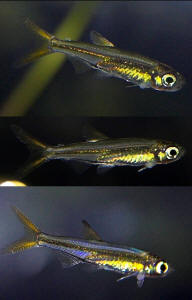
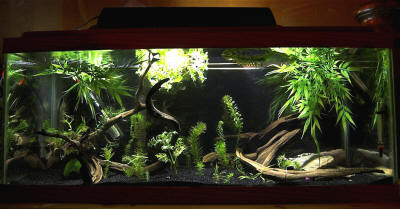 |
Red Phantom Tetra can't open his mouth
12/18/10
Hi Crew,
<Chris>
I hope you can shed some light on this problem. Here's my
set-up:
20 gallon tank
Ammonia 0, Nitrites 0, Nitrates 10
8 red phantom tetras, 1 Farlowella, 1 dwarf Gourami, 6 peppered Cory
cats
live plants
temp 76
I've had this tetra in question for 2+ years. A bit of background
that may or may not be relevant - he was either born with a curved
spine, or he was injured on the trip to the LFS. From day one you could
see his spine was curved. However, he has been fine for 2+ years, could
swim just fine though perhaps he is tipped upward a little bit when he
is stationary but otherwise has been normal.
<I see>
I noticed a few days ago he seemed to be moving a lot more, constantly
swimming but not as he normally would. He is tipped upright more than
usual and never rests even for a second. He also seems to be a bit
stiff in part of his body but I can't quite put my finger on where
(possibly his upper body but hard to tell).
When I fed the fish he seemed to react and swim around the food, but
made no attempt to eat. I knew something else was off about him and
couldn't put my finger on it until tonight...he isn't opening
his mouth at all! Not to eat, or as fish normally open and close their
mouths. It is like his mouth is fused shut.
<Mmm, happens...>
I put a magnifying glass up to him and don't see any growth or
obstruction but he is so quick to move it is hard to tell.
Should I put him in a separate tank (and possibly treat with
something?).
Any idea what this is, and are my other tetras at risk?
<I'd leave this fish where it is. Not "catching"...
either developmental or a trauma (bump into something hard)... Will
cure of its own or this fish will perish in time from a lack of
nutrition>
Thanks so much for your time!
Chris
<Welcome. Bob Fenner>
|
Neon tetras--strange growths
4/24/07 Thanks for an excellent resource! I did peruse the FAQs
before sending, and cropped and reduced the attached photos.
<Good> In general, my 20 g long tank is fine. It's a
planted tank (java ferns, dwarf sag, Christmas moss, Monoselium
tenerum) with 1 SAE, a number of "wild cherry" shrimp
(Neocaridina denticula sinensis) and 12 neon tetras. I've had
some of the Neons for a couple of years; I added 6 a few
months ago. The tank in general is doing well. The younger Neons
spawn regularly ( I just saw them doing it a few minutes ago.) I
was about to test the water for pH before I sent this e-mail, but
found I was out of reagent. It usually tests around neutral in the
tank, out of the tap it's usually 8.0, but I have the tank on
DIY CO2. <Very good> The temperature is usually at about 73
F, but they've been goofing with the A/C in my office building,
so now its a bit cool (70 F.) Anyway, some of the older
Neons have this strange growth as you can see in the picture. It
started months ago on one of them, but didn't/doesn't grow
very quickly at all, and at first did not seem to affect other fish
in the tank, but as you can see, that has recently changed. It
often seems to start as a small growth on the mouth, and then shows
up elsewhere. There are about 6-7 Neons in the tank that are
unaffected, and about the same number that are, to varying degrees.
I have a tank at home that stays in the low 80s (we live in Hawaii,
no A/C at home) <Am out on the Big Island currently... mauka of
Kona... at about 1,400 feet elevation... as many folks do here for
moderation of seasonal temp.> with white clouds in it. I was
wondering...would it be a good idea to swap tanks? <Mmm, yes>
I know the Neons like it warmer, and the white clouds like it
cooler... but would it be better to put a heater in this tank,
rather than risk infecting the white clouds with whatever this
growth is? <I don't think this growth, condition is
"catching" from the Neons to Tan's fish...> Once
again, thanks for an excellent resource! I appreciate your help
tremendously!! Rus Wilson <Thank you for writing, sharing... I
would switch out these two fish groups... I strongly suspect that
the better part of the older Neon condition is largely
age-influenced... They only live a few years... And would not
attempt actual treatment/s other than to move them to the warmer
setting. Bob Fenner>
|
|
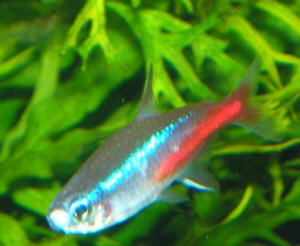
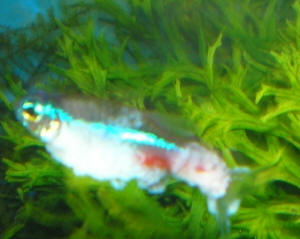
|
Fish can't swim, FW mysterious paralysis in
Tetras -- 03/09/07 Hello, I am having an issue with the fish
in one of my tanks everything water wise is fine (ammonia 0, nitrite 0,
and nitrate 10) and it is a heavily planted tank. but a couple of the
fish have died and a couple that are alive seem to have rigor mortis in
their tails and can barely swim( they are couple of Rio von tetras and
green flame tetra). CJ <Yikes... very strange... and no way to
diagnose w/o much more information... I would do the S.O.P. in such
anomalous cases, a good-sized water change (perhaps half) and addition
of a chemical filtrant (likely activated carbon, or a product with a
preponderance of such). Now! Bob Fenner>
Sick Phantom - 10/21/2006
Hello,
<Hi, Camille. First, I apologize for the delay of this
reply. It was not easily accessible by our mail system,
unfortunately.> I have a sick Black Phantom tetra and I'm not
sure how to help her. She has a rapid respiration rate, and
is having difficulty keeping herself upright; she tends to flop over on
to her side, or her head points down towards the gravel and her tail
points up towards the water surface. She's still eating, and I
don't see other visible signs of disease (no discolorations, bumps,
fungus, parasites, ragged fins, etc'¦). She
displayed similar symptoms a few months ago and I was not sure what to
do for her, so I moved her to a quarantine tank with a little aquarium
salt added, <This was an excellent move - though I would have used
Epsom salt (Magnesium Sulfate) instead or in addition to the aquarium
salt.> included a little bit of Aquari-sol (although I admittedly
had no idea if this was the best idea or not'¦), <I would
not have recommended this.> and fed her sparingly for a
week. Her condition improved greatly and I put her back in
the main tank. <Great!> A few weeks ago, I noticed
she was starting to list to the side a bit again. Her
condition has gradually worsened, and I now have her back in the
quarantine tank. I have not started any kind of treatment
yet, and would surely welcome some good, expert advice!
<I'd add Epsom salt (Magnesium Sulfate) at a rate of 1-2
tablespoons per ten gallons. Aquarium salt certainly
won't hurt, and may help. I'd recommend strongly
that you look very closely for any other symptoms - gray/filmy skin,
any other abnormalities.... And perhaps also try giving her
some foods of high roughage content - shelled peas or adult brine
shrimp, perhaps. These along with the Epsom salt will help
to pass any gut blockage that may be affecting her
swimming. Withhold all other foods for a time.> My main
tank is 55 gallons, planted with low-light plants (no CO2
added). The tank has been set up for about one
year. Water conditions have been stable for a long time: pH
7.3 Nitrate 20 Ammonia 0 Nitrite 0 Temp 80 I do a 10 to 15% water
change every one to two weeks. I use AquaSafe to remove
Chlorine/Chloramines. I add Seachem's Flourish once a
week and Excel 2 or 3 times weekly for the plants.
<Sounds great, though you may want to do larger water changes; the
Nitrate's just at the edge of "okay".> Tank
inhabitants: 4 Black Phantom tetras (2 males, 2 females) 5 Pristella
tetras 6 Neon tetras 6 Panda Corys 3 Otocinclus All other fish seem to
be fine. What course of action would you recommend I follow
to help my tetra? <Just as above.> Any advice or
suggestions will be greatly appreciated! Thank you for your
time. Best regards, Camille <All the best to
you, -Sabrina>
| Is my Congo tetra carrying eggs?
7/6/06 Hello WWM Crew, <Jim> Simple a quick question, and
yes I have searched around but I think it's just too simple and
I am too cautious. Judging from the attached photo, is
my Congo tetra prego? If not, what could it
be? It is acting perfectly normal and holding up its
part of the 6 member school. Thanks in advance for your help. Best
regards, Jim <If carrying eggs, not many... Looks more like an
infection from the pinkish coloring in the vent area. At this
juncture I would just keep observing... Bob Fenner> |
|
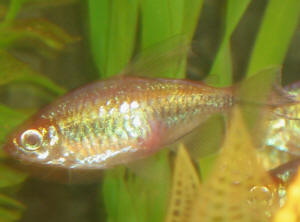
Re: Is my Congo tetra carrying eggs?
7/9/06 Hi Everyone, <Jim> An update. The lump on
my Congo tetra, described below, has definitely not gotten any smaller
and continues to be red. Could the fish's vent be
plugged up? <Mmm, possibly, yes> Can anything be
done? It continues to act normally, swimming with the rest
of 'em and eating, etc. Thanks again, Jim <Mmm, well, there are
"laxatives" in the way of foods... like the feeding of brine
shrimp (Artemia) or Daphnia... that might help here. Even the careful
addition of Epsom Salt (see WWM re:
http://www.wetwebmedia.com/FWSubWebIndex/saltusefaqs.htm But I
would take a "wait and see" approach here if this fish
appears okay otherwise. It may well "self-heal" in your good
care. Bob Fenner>
|
What are these things! FW Neons, Ich...
3/27/06 Dear WWM Crew, I have recently had all my neon tetras die.
The first one to go (thing 1) had dropsy and was really sad because he
had been a part of my aquarium for over a year. I went to the local
aquarium to get two replacements to keep my second neon company. Within
2 days both of the new guys died. I tested my water and everything was
fine. <Can't tell from here> The following day I bought
another neon tetra and named in speckles (It had white dots sprinkled
over its body and fins). <Perhaps if you named them after
prophets...> This one soon died too, followed by my second neon
tetra (thing 2). I noticed my other fish began having white dots as
well. <Oops... likely not related... but Ich> (I have a flame
tetra, two Gouramis, a Serpae tetra) Doing my research, I assumed Ich
and began treating the tank with CopperSafe, as recommended by the
aquarium store. <... I would NOT treat small characins/Tetras with
Copper products... but half doses of Malachite Green, elevated
temperature... posted on WWM> Paying closer attention to the tank, I
can see many tiny white bugs moving on the glass and floating in the
water that were not there before. <These also are very likely
unrelated...> Can these white bugs be what is on my fish? Are they
parasites hurting my fish? Thank you for your time, Jackie <The
initial losses were probably due to simple differences in your
store/sources water quality, acclimation and your system... the Ich was
likely imported on some of the new fish... the bugs are likely living
on the nutrients, food... You need to "step up" your
maintenance, treat the Ich with something less toxic (likely clean the
tank a bit first, or better, treat the fish elsewhere...), and not
worry re the apparent "bugs". Please read here: http://wetwebmedia.com/FWSubWebIndex/fwich.htm
and the linked files above. Bob Fenner>
Pop Eye on Tetra 2/18/06 I have a 100 gallon tank with
2 magnum filters going on. One of my tetras has a bubbled eye. What do
I do? I need help. I have put him by himself in a small tank 10 gallon
with half water which is 5 gallon water & did put that tablet
fungus clear tank buddies. Do I have to add Epsom salt with it.?.
Kindly respond. thanks. Godfrey < Treat the tank with the sick tetra
with Metronidazole. The original tank may have elevated nitrate
readings and so check the levels. They should be under 25 ppm although
some fish like them lower.-Chuck>
My poor tetra... dropsy 1/17/06 Hello
I have a question regarding my
tetra. For the last 5 days or so my fish has been in the
bottom corner of our 10 gal tank. It can swim for a second
then falls right back to the bottom of the tank. I have two
other tetras in the same tank and they are fine. I don't
know what a pregnant tetra looks like but this one is very fat and the
scales are sticking out, <... Ascites... in pet-fishing called
dropsy, or a Dropsical condition... aptly called "pinecone
disease" in Japanese> the side looks red. I have
read about the different diseases and it seems like the fish might have
a disease but the others ones don't. I had my water
tested when I took it into the pet shop and it is OK so I am
stumped. Would a fish not be able to swim if it had a
disease and Say the fish is pregnant how long does it take to lay the
eggs? <Depends on species... days to a few weeks> Should I take
the fish out of the tank? IF so what is the best
way? I am not to sure on fish stuff but I don't like to
see fish suffer. <If you sense this fish should be sacrificed,
placing it in a plastic bag with a little water and putting this in the
freezer will painlessly euthanize it. Likely the "cause" of
the dropsy here is not "catching"... Bob Fenner>
Silver Dollars with Fin Damage 8/21/05 I asked for help a
while ago with my Silver Dollars looking extremely poorly. Ich causing
large sores on their sides, and fin rot, you suggested a Furan based
medicine and the continued use of Rid-Ich+. I'm now using
Furazone-green (contains: Methylene Blue: 2.5mg, Nitrofurazone
(Monofuracin): 122mg, and Furazolidone: 24.4 mg.) and I've doubled
the dosage to one capsule twice a day as directed on the package as
well as the Rid-Ich+. I've been treating one silver dollar in a ten
gallon tank setup with no substrate under my 90 gallon for 10 days now.
Figured this was a good location as this is a large, stressful fish and
its inside a cabinet. I've noticed the major loss of Ich, and the
slowly shrinking sores, but the fins, though no longer discolored, have
not seemed to have grown whatsoever. I was wondering what other
practices I could take to speed this process, perhaps lowering the ph
and adding softer water (distilled percentage)? <After the sores are
gone then the disease is practically cured. Now the fish needs to heal.
Sometimes the fins get fungused too. These fungused fins to not
regenerate. You will need to remove the fish from the water and clip
the fins back to past the damaged area. they will then regrow but not
as nice as if they were never damaged. Fins diseased back into the
caudal peduncle usually do not regenerate.> The ten gallon does have
a large filter, in fact its an old, fully cultured penguin 330
Bio-wheel, I shut this down for about 45 minutes every time I add
medicine. I'm only changing water when the fish seems to be
breathing harder than normal, should I be changing it more often? Any
specific help is greatly appreciated. Thanks again!!! < Check the
nitrates. The disease causing bacteria continue to thrive when
nitrogenous wastes are present.-Chuck>
Silver Dollar Question 8/23/05 One more question please:
after the sores are cleared, and their fins are clipped back, do I
still have to quarantine them? Or can they go back in the 80 gal? <
Put them back into the quarantine tank until the fins start to grow
back.-Chuck>
Silver Dollar Problems 8/21/05 Ok, this makes sense, the
silver dollars never had good fins from the day I got them with my used
tank purchase, from what I understand they are quite old fish, around 5
years old. But no matter, I'm not too much worried about the way
the fins look, as long as the sores close up. How do you suggest
restraining the fish out of water? Under a towel, and I imagine this
should be done in intervals of just a few seconds. Thanks for
replying!!! < If you want to take them out to clip the fins then you
take a large soft net and catch them. In a shallow dish you place a
clean bath towel that has been soaked in the aquarium water. Catch the
fish and place him on the towel and cover him up with only the section
you want to work on exposed. Use fingernail clippers to trim the fins
back past the damage. Silver dollars have very fine delicate scales
that are easily damaged. If the areas get damaged then you might be
back to square one.-Chuck>
Paralyzed Tetra 8/11/05 Dear Crew,
<Stacy> The other day, I noticed that a tetra I've had with 3
others in a tank for over 2 years was lying on its side at the bottom
of the tank. I have no idea what caused this, and figured
old age was kicking in, and he would likely die soon. <Likely so>
The other fish are doing fine. Today, it is still on its
side on the bottom of the tank. It is breathing, it's
eyes are functioning and one side of its body is moving. But
that is all. It's as if it is paralyzed on one side.
<Happens> I have no idea what to do, and can't bear to let it
suffer this way. He's been this way for three days
now. What do I do? <It is likely not suffering, but if
the prospect of this bothers you, you might euthanize this fish... in a
bit of water, in a plastic bag... in the freezer> And
what is the most merciful way to put him out of his
misery? Or is there some way I can help him recover?
<Probably will not recover... but there is always a chance> Any
help you can offer is most appreciated... Stacy <Small tetras often
only live a few years... Bob Fenner>
Re: Paralyzed Tetra 8/11/05 Dear Crew, Stacy> Thanks so
much for your quick reply. The poor little guy is still on
his side breathing rapidly, with one fin trying desperately to swim,
but no luck. He's still at the bottom of the tank,
gulping food when it comes his way. The others are leaving
him alone. I've had 4 tanks for 10 yrs and have never had this
problem...It really baffles me. I'm going to go ahead and euthanize
him if there's no improvement tonight, as I just feel like he is
suffering, and he has been this way for far too long. (I
found your euthanization page online after a lot of exploration
yesterday.) Thanks for a wonderful, and very informative,
site for all of us "novice fish enthusiasts". I
will be doing a lot of referrals to your site in the
future! Stacy <Life to you my friend. Bob Fenner>
|
|

